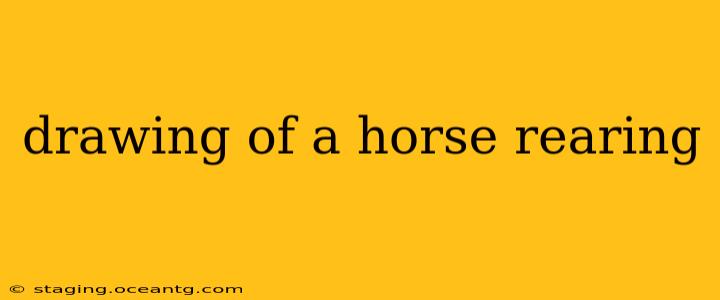Drawing a rearing horse is a challenging but rewarding endeavor. It requires capturing the dynamic energy and complex anatomy of the animal in a powerful pose. This guide will break down the process step-by-step, addressing common questions and offering tips to help you create a stunning piece of equine art.
What are the Key Steps in Drawing a Rearing Horse?
The process of drawing a rearing horse can be broken down into several key steps:
-
Skeleton and Basic Structure: Begin with a simplified skeletal structure. Think of the horse's body as a series of interconnected shapes (circles, ovals, rectangles) to establish the overall proportions and posture. This foundational step is crucial for accuracy and realism.
-
Musculature: Once the basic skeleton is in place, gradually add muscle mass over the skeletal structure. Focus on the powerful muscles of the legs, shoulders, and neck. Observe reference images carefully to understand how the muscles contract and bulge during this dynamic pose.
-
Refining the Form: Refine the form by adding details to the muscles, outlining the body's curves, and indicating the horse's coat texture. Pay attention to the way light and shadow play on the horse's body to create depth and volume.
-
Adding Details: Incorporate details like the horse's mane, tail, and facial features. Pay close attention to the expression in the horse's eyes; a rearing horse often displays alertness and power.
-
Final Touches and Background: Add final details such as the background, hooves, and any other elements you wish to include. The background should enhance the overall composition and story.
What are Some Tips for Drawing a Rearing Horse?
-
Use References: Study photographs and videos of rearing horses. This will help you understand the horse's anatomy, musculature, and overall movement.
-
Start with Simple Shapes: Avoid getting bogged down in details at the beginning. Start with simple shapes to establish the basic proportions and pose before adding details.
-
Focus on the Balance: A rearing horse is inherently unstable. Pay close attention to the balance and weight distribution to ensure the drawing looks realistic and believable.
-
Practice Regularly: Drawing a rearing horse takes practice. The more you practice, the better you'll become at capturing the dynamics of this challenging pose.
-
Vary Your Medium: Experiment with different drawing mediums, such as charcoal, pencils, pastels, or digital painting.
How Do I Draw the Legs of a Rearing Horse?
The legs are a crucial element of a rearing horse drawing. They should convey the immense power and effort involved in the pose. Focus on the following:
-
Perspective: Pay close attention to perspective; the legs closest to the viewer will appear larger and more detailed than those further away.
-
Musculature: Emphasize the powerful muscles of the horse's legs and how they contract and extend in the rearing position.
-
Hooves: Hooves should be accurately drawn and detailed; they should appear solid and grounded, even though the horse is off the ground.
What are the Different Perspectives for Drawing a Rearing Horse?
The perspective from which you draw the rearing horse dramatically impacts the final image.
-
Front View: A front view showcases the horse's powerful chest and neck.
-
Side View: A side view allows for a more detailed representation of the horse's musculature and balance.
-
Three-Quarter View: A three-quarter view offers a dynamic composition, combining aspects of both front and side views.
How Do I Capture the Energy and Movement of a Rearing Horse?
Capturing the energy of a rearing horse involves paying attention to:
-
Lines of Action: Use dynamic, flowing lines to convey the horse's movement and power.
-
Implied Motion: Suggest motion through the implied movement of the mane and tail.
-
Expression: The horse's expression is crucial; it should reflect its power and energy.
Drawing a rearing horse is a challenging but ultimately rewarding experience. By following these steps and tips, and by practicing regularly, you can create a stunning and dynamic representation of this majestic animal. Remember consistent practice and referencing real-life examples are your best allies in mastering this art form.
